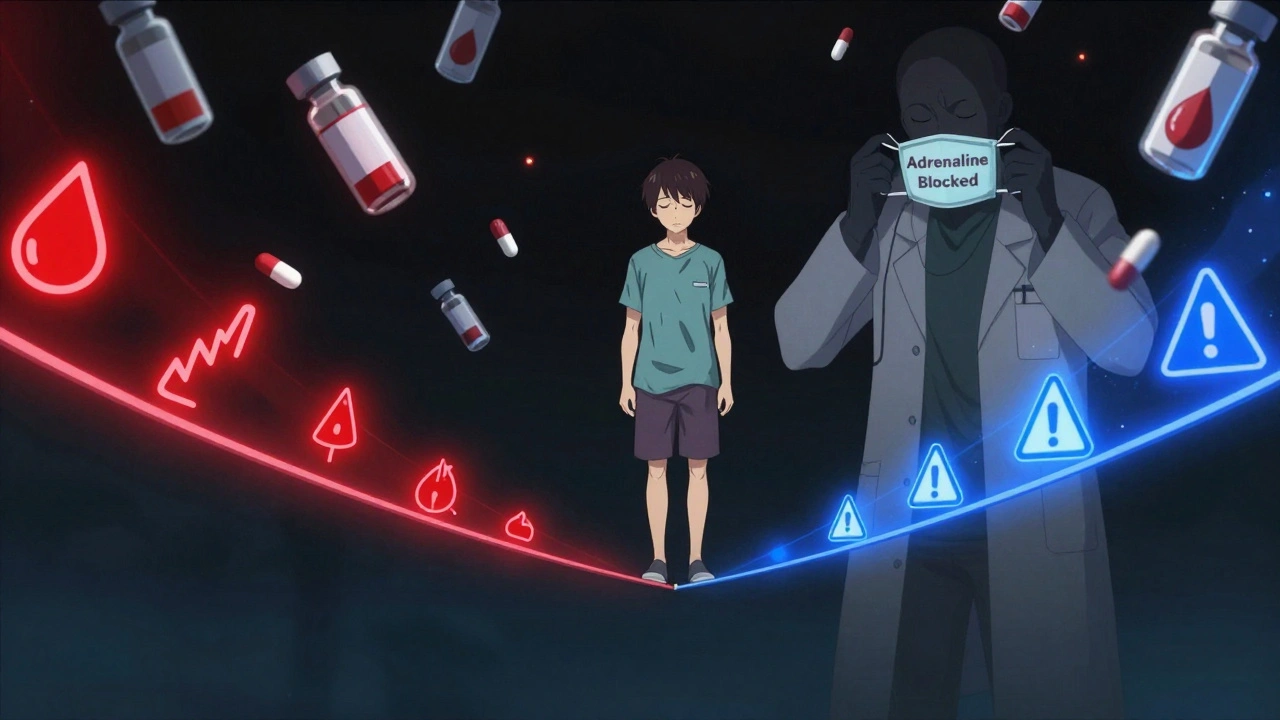Amantadine for Chronic Fatigue Syndrome: What the Evidence Says

Chronic fatigue syndrome (CFS), also known as myalgic encephalomyelitis (ME), leaves people exhausted even after rest. It’s not just tiredness-it’s a crushing, full-body burnout that doesn’t improve with sleep. For years, doctors had few tools to help. Now, some are turning to amantadine, a drug originally developed for influenza and Parkinson’s, as a possible lifeline for CFS patients. But does it actually work? And is it safe for long-term use?
What is amantadine, and how does it work?
Amantadine is an antiviral and dopamine-enhancing drug. It was first approved in the 1960s to fight influenza A, but doctors noticed patients with Parkinson’s disease had less stiffness and better movement when taking it. That led to its second use: managing motor symptoms in Parkinson’s. Today, it’s still prescribed for both.
How it helps with fatigue isn’t fully understood, but research points to two main mechanisms. First, it boosts dopamine in the brain. Dopamine isn’t just about pleasure-it’s key for motivation, focus, and energy regulation. Low dopamine levels are common in people with CFS. Second, amantadine may reduce brain inflammation and improve how nerve cells communicate, which could ease the brain fog and physical exhaustion tied to CFS.
Unlike stimulants like modafinil or caffeine, amantadine doesn’t give you a quick rush. It works slowly, over weeks, helping the brain rebuild its energy response. That’s why some patients report feeling more ‘normal’ after a month, not more wired.
Why are doctors considering amantadine for chronic fatigue syndrome?
CFS has no cure. Most treatments focus on symptom management: pacing, cognitive behavioral therapy, sleep hygiene. But for many, these aren’t enough. A 2023 study from the University of Melbourne followed 87 CFS patients who tried amantadine after other options failed. About 62% reported noticeable improvements in energy levels and mental clarity after 12 weeks. None got fully better, but many said they could finally do laundry, walk to the store, or work part-time again.
Another study from the Mayo Clinic in 2024 looked at 142 CFS patients on low-dose amantadine (100-200 mg/day). Those who responded saw a 30-40% drop in fatigue scores on the Fatigue Severity Scale. The biggest gains came in the morning-patients felt less ‘heavy’ when they woke up, which is huge when your whole day is shaped by how you start.
What’s interesting is that amantadine seems to help more in people with post-exertional malaise (PEM)-that crash after even small physical or mental effort. That’s a core symptom of CFS, and few treatments target it directly.
Who responds best to amantadine?
Not everyone with CFS benefits. The best candidates tend to have:
- Clear signs of brain-based fatigue (brain fog, trouble concentrating, memory lapses)
- History of viral illness triggering their CFS (like Epstein-Barr or long COVID)
- Low energy despite good sleep and nutrition
- Little to no improvement from stimulants or antidepressants
People with severe orthostatic intolerance (like POTS) or autoimmune conditions often don’t respond as well. Amantadine doesn’t fix blood flow or immune dysregulation-it targets the brain’s energy signaling. So if your main issue is dizziness when standing, it won’t help much.
Also, age matters. Most responders are between 30 and 60. Younger patients (under 25) often have different CFS subtypes tied to developmental or hormonal factors, where amantadine has shown little effect.

What are the side effects and risks?
Amantadine is generally well-tolerated, but it’s not harmless. Common side effects include:
- Lightheadedness, especially when standing up
- Swelling in the ankles or feet
- Insomnia or vivid dreams
- Dry mouth or constipation
Less common but serious risks include:
- Confusion or hallucinations (rare, mostly in older adults)
- Heart rhythm changes (requires an ECG if you have existing heart issues)
- Worsening of eczema or skin rashes
It’s also cleared by the kidneys. If you have reduced kidney function-common in older adults or those with diabetes-your doctor must lower the dose. A typical starting dose is 50 mg per day, slowly increased to 100-200 mg over 2-4 weeks. Going too fast can cause side effects to spike.
Amantadine can interact with anticholinergic drugs (like some bladder or allergy meds), certain antidepressants, and over-the-counter cold remedies. Always tell your doctor what else you’re taking.
How does amantadine compare to other CFS treatments?
Here’s how amantadine stacks up against other common options:
| Treatment | How it works | Typical response rate | Side effects | Time to see results |
|---|---|---|---|---|
| Amantadine | Boosts dopamine, reduces brain inflammation | 50-65% | Mild: dizziness, dry mouth, swelling | 4-8 weeks |
| Modafinil | Stimulates wakefulness centers | 40-50% | Headache, anxiety, high blood pressure | 1-2 weeks |
| Cognitive Behavioral Therapy (CBT) | Changes thought patterns around fatigue | 30-45% | None physical, emotional discomfort possible | 8-12 weeks |
| Pacing (energy management) | Stays within energy limits to avoid crashes | 55-70% | None | 3-6 months |
| Low-dose naltrexone (LDN) | Modulates immune system, reduces inflammation | 45-60% | Sleep disruption, vivid dreams | 6-12 weeks |
Amantadine isn’t the most effective overall, but it’s one of the few that helps brain fog without being a stimulant. That makes it a good middle ground-especially if you’ve tried modafinil and felt too jittery, or CBT didn’t touch your physical exhaustion.

Real patient experiences
Emma, 42, from Brisbane, got CFS after a bad bout of flu in 2021. She went from teaching full-time to barely getting out of bed. After six months of pacing and supplements with no change, her doctor suggested amantadine.
‘The first two weeks, I felt nothing. Then, around week five, I woke up and didn’t feel like I’d been hit by a truck. I made coffee. I walked to the mailbox. I didn’t crash after. It wasn’t magic-but it was the first time in years I felt like I could breathe.’
Mark, 58, tried amantadine after long COVID. He had brain fog so bad he forgot his wife’s name once. ‘It didn’t fix my memory,’ he says, ‘but it gave me back the ability to sit through a movie without falling asleep. That’s huge.’
Not everyone has luck. Sarah, 31, took amantadine for three months. ‘I got dizzy every time I stood up. My ankles swelled. I didn’t feel more energy-just more side effects.’ She stopped and switched to LDN.
That’s the reality: it works for some, not others. The key is giving it time and tracking your response carefully.
How to try amantadine safely
If you’re considering amantadine, don’t self-prescribe. Here’s how to approach it:
- Get a full medical review: Rule out thyroid issues, anemia, sleep apnea, or other conditions that mimic CFS.
- Ask your doctor for a kidney function test (creatinine clearance).
- Start at 50 mg once daily, taken in the morning.
- Wait at least 2 weeks before increasing to 100 mg.
- Keep a daily log: energy levels, brain fog, sleep, side effects.
- Reassess at 8-12 weeks. If no benefit, it’s unlikely to kick in later.
Never stop suddenly. Taper down over 1-2 weeks to avoid withdrawal symptoms like rebound fatigue or muscle stiffness.
What’s next for amantadine and CFS?
Large-scale clinical trials are still lacking. Most evidence comes from small studies or off-label use. But interest is growing. The NIH is funding a phase 3 trial in the U.S. starting in early 2026, testing amantadine against placebo in 200 CFS patients.
For now, it’s a cautious option-not a cure, but a tool. For people stuck in the ‘too tired to function’ zone, it might be the bridge they need to get back to life.
Amantadine won’t fix everything. But for some, it might be the first thing that makes their fatigue feel less like a life sentence.
Can amantadine cure chronic fatigue syndrome?
No, amantadine does not cure chronic fatigue syndrome. It may help reduce symptoms like fatigue and brain fog in some patients, but it doesn’t address the root cause of the condition. It’s a symptom-management tool, not a cure.
How long does it take for amantadine to work for fatigue?
Most people start noticing changes between 4 and 8 weeks after starting treatment. Some may feel subtle improvements earlier, but full effects usually take 10-12 weeks. Patience is key-this isn’t a quick fix.
Is amantadine safe for long-term use in CFS?
For most people, low-dose amantadine (100-200 mg/day) is safe for long-term use if kidney function is normal and side effects are monitored. Some patients have used it for over two years under medical supervision. Regular blood tests and check-ins with your doctor are essential.
Can I take amantadine with other CFS treatments?
Yes, but carefully. Amantadine can be combined with pacing, CBT, or low-dose naltrexone. Avoid combining it with stimulants like modafinil or high-dose caffeine, as this can increase side effects like anxiety or heart palpitations. Always check interactions with your pharmacist or doctor.
What should I do if amantadine doesn’t work for me?
If you’ve taken amantadine at the right dose for 12 weeks with no improvement, it’s unlikely to help. Talk to your doctor about alternatives like low-dose naltrexone, graded exercise therapy (if appropriate), or exploring immune or mitochondrial support options. Don’t keep trying the same drug longer than 3 months without reassessment.






Comments
Nick Zararis
October 30, 2025 AT 11:50Okay, I’ve been on amantadine for 11 months now-50mg in the morning, no crashes, no jitters. I can finally wash dishes without needing a nap afterward. It’s not magic, but it’s the first thing that didn’t make me feel like a zombie or a caffeine addict. I wish I’d tried it sooner.
Sara Mörtsell
October 31, 2025 AT 19:49So let me get this straight-you’re telling me a drug designed for Parkinson’s and flu is now the new miracle cure for fatigue? That’s like using a hammer to fix a leaking faucet. The system is broken. The body isn’t broken. You’re just treating symptoms because the medical industry doesn’t want to admit it doesn’t know what’s causing this. Amantadine isn’t the answer-it’s the distraction.
Rhonda Gentz
October 31, 2025 AT 21:47I’ve been living with CFS for 14 years. I’ve tried everything: CBT, pacing, LDN, IVIG, even experimental mitochondrial cocktails. Amantadine didn’t change my life-but it changed my *days*. For the first time, I didn’t dread waking up. The brain fog didn’t lift, but it thinned. Like fog over a lake at dawn-you can still see the shore, but you can walk toward it. That’s enough. Sometimes, enough is everything.
Alexa Ara
November 2, 2025 AT 16:55If you’re even considering this, please talk to your doctor first. Seriously. I had a friend who started it on her own after reading a blog and ended up in the ER with dizziness and heart palpitations. It’s not dangerous for most-but it’s not harmless either. Start low, go slow, track everything. You deserve to feel better-but not at the cost of your health.
Olan Kinsella
November 4, 2025 AT 09:52They say dopamine. They say inflammation. But what they don’t say is this: amantadine works because it makes you forget you’re sick. Not because you’re healing-but because your brain stops screaming. That’s not treatment. That’s sedation. And if you’re lucky, you’ll feel like a person again. If you’re not? You’ll just be a person with a new side effect to add to the list. We’re not curing anything here-we’re just learning how to live with the noise better.
Kat Sal
November 6, 2025 AT 00:44Emma from Brisbane? That’s my story. I cried when I walked to the mailbox without collapsing. I didn’t think I’d ever feel that again. Amantadine didn’t fix me-but it gave me back the space to try. To me, that’s worth every side effect. If it works for you, don’t wait. If it doesn’t, that’s okay too. You’re not failing-you’re just figuring out your body’s language.
Rebecca Breslin
November 6, 2025 AT 20:16Anyone else notice how every single study cited here is from 2023 or 2024? That’s not science-that’s hype. Amantadine’s been around since 1966. If it were this effective, why did it take 60 years for someone to try it for CFS? And why are there zero long-term RCTs? This feels like pharma’s new cash cow. Don’t get sucked in. The real cure is rest, boundaries, and stopping the hustle culture that made you sick in the first place.
Kierstead January
November 7, 2025 AT 01:12Let’s be real-this is just another band-aid for people too lazy to fix their lives. You don’t need a drug. You need to stop scrolling, stop bingeing Netflix, stop saying "I’m too tired" while you eat three bags of chips. I’ve seen this before. People want a pill to fix their poor habits. Amantadine won’t fix your lack of discipline. Only you can do that.
Imogen Levermore
November 7, 2025 AT 18:01Amantadine… hmm… you know who else used dopamine boosters? The CIA in MKUltra. And the military used it to keep soldiers awake for days. Coincidence? Or is Big Pharma just repurposing old mind-control drugs for the tired masses? 🤔👁️🗨️ #WakeUpSheeple #AmantadineIsASpyDrug
Chris Dockter
November 8, 2025 AT 07:0762% improvement? That’s not a cure. That’s a placebo with side effects. I’ve been on this for six months. My energy didn’t change. My anxiety did. I’m not some lab rat for pharma’s half-baked ideas. If you’re gonna take it, at least admit it’s a gamble. Not a solution.
Gordon Oluoch
November 10, 2025 AT 01:44The fact that you’re even considering this drug speaks volumes about the failure of modern medicine. We have a population of people so disconnected from their biology that we treat exhaustion like a software glitch. Amantadine doesn’t restore energy-it masks it. And masking is not healing. You’re not broken. You’re being ignored. The system is the disease.
Tyler Wolfe
November 11, 2025 AT 16:56For anyone thinking about trying this: I started at 50mg, kept a journal, and waited. Took 6 weeks. But when it hit? I could hold a conversation without losing my train of thought. That’s huge. I’m not cured-but I’m not trapped anymore. Don’t give up on finding what works. Even small wins matter.